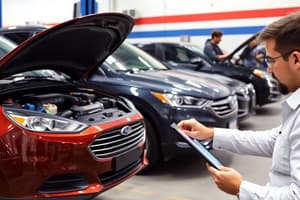Podcast
Questions and Answers
Why is proper tire pressure important?
Why is proper tire pressure important?
- To improve vehicle speed
- To reduce tire wear
- To improve fuel efficiency, handling, and safety (correct)
- To improve vehicle appearance
What should you do when checking tire pressure?
What should you do when checking tire pressure?
- Check the pressure every week
- Check the pressure only when the tire is worn out
- Check the pressure when the tires are hot
- Use a tire pressure gauge and check the owner's manual for recommended pressure (correct)
What is a consequence of underinflated tires?
What is a consequence of underinflated tires?
- Improved handling
- Reduced risk of tire failure
- Increased tire wear (correct)
- Improved fuel efficiency
How often should you replace your wiper blades?
How often should you replace your wiper blades?
What is the importance of coolant in a vehicle?
What is the importance of coolant in a vehicle?
What should you check when inspecting your wiper blades?
What should you check when inspecting your wiper blades?
What happens if the coolant level is low?
What happens if the coolant level is low?
What type of wiper blades are suitable for winter conditions?
What type of wiper blades are suitable for winter conditions?
How often should you check your washer fluid level?
How often should you check your washer fluid level?
Why is it essential to have good visibility while driving?
Why is it essential to have good visibility while driving?
Flashcards are hidden until you start studying
Study Notes
Vehicle Maintenance
Tire Pressure
- Importance: Proper tire pressure improves fuel efficiency, handling, and safety.
- How to check:
- Use a tire pressure gauge.
- Check the owner's manual for recommended pressure.
- Check pressure when tires are cold.
- Consequences of underinflation:
- Reduced fuel efficiency.
- Increased tire wear.
- Increased risk of tire failure.
- Consequences of overinflation:
- Reduced traction.
- Increased risk of tire failure.
Wiper Blades
- Importance: Good visibility is crucial for safe driving.
- How to inspect:
- Check for signs of wear (cracks, tears, etc.).
- Check for proper fit and alignment.
- When to replace:
- Every 6-12 months or when showing signs of wear.
- Replace both blades at the same time for optimal performance.
- Types of wiper blades:
- Conventional.
- Beam-style.
- Winter-specific.
Coolant
- Importance: Coolant prevents engine overheating and damage.
- How to check:
- Check the owner's manual for the recommended type of coolant.
- Check the coolant level regularly.
- Check for signs of leakage or contamination.
- Consequences of low coolant levels:
- Engine overheating.
- Engine damage.
- Types of coolant:
- Ethylene glycol-based.
- Propylene glycol-based.
- Organic acid technology (OAT).
Washer Fluid
- Importance: Good visibility is crucial for safe driving.
- How to check:
- Check the washer fluid level regularly.
- Check the type of washer fluid used (summer, winter, or all-season).
- When to replace:
- When the level is low.
- When the fluid is contaminated or dirty.
- Types of washer fluid:
- Summer: water-based.
- Winter: freeze-resistant.
- All-season: balanced formula for year-round use.
Studying That Suits You
Use AI to generate personalized quizzes and flashcards to suit your learning preferences.




